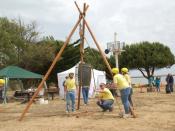If the grapevine were the only communication in the work place, then it would have great value; but rumors are not always accurate. Peak (2007) relates to Mark Twain's quaint quote, "The difference between the right word and the almost right word is the difference between lightning and lightning bug." All the barriers of communication are present in the grapevine. Forexample, if the receiver is not a good listener, they may not get the story right and distort it through the grapevine.
Getting the message through the grapevine is not only horizontal communication, but generally peer to peer. Although it would not be uncommon to have a supervisor casually transmit perhaps confidential, perhaps inaccurate downward communication to a subordinate, which then of course is broadcast through the horizontal plane. Hence the name grapevine; the multi directional communication irrespective of authority level. Peak (2007) relates that grapevine communication is called "scuttlebutt" a navy slang term for rumors and gossip derived from the name given the keg or cask or water called a "butt" that had a scuttled hole to get the water out.
The sailors gathered around the scuttlebutt exchanging stories like employees gather around the break room or the water fountain where they share gossip and find out what is going on. "Scuttlebutt" can hinder truthful communication, especially in police agencies where it is carried 24/7 to each new shift (p. 34).
On the other hand, the grapevine is fast. It is beneficial to managers because they can sense the morale and attitudes the employees have through the rumors. Employees may relish the news they get through the grapevine, breaking the boredom and monotony, especially when confined to mundane positions. Grapevine communication is a social structure that builds relationships, teamwork, and morale of the employees (Peak, 2007...


